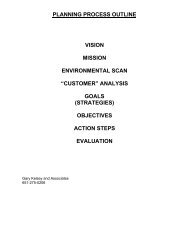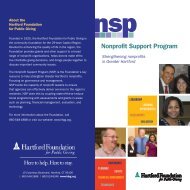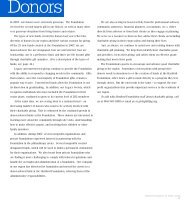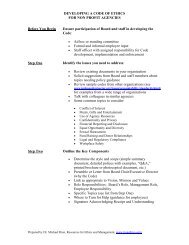Peter Brinckerhoff - Hartford Foundation for Public Giving
Peter Brinckerhoff - Hartford Foundation for Public Giving
Peter Brinckerhoff - Hartford Foundation for Public Giving
You also want an ePaper? Increase the reach of your titles
YUMPU automatically turns print PDFs into web optimized ePapers that Google loves.
Mission-Based Management In<br />
Difficult Financial Times<br />
<strong>Peter</strong> <strong>Brinckerhoff</strong><br />
<strong>Hart<strong>for</strong>d</strong> <strong>Foundation</strong> <strong>for</strong> <strong>Public</strong> <strong>Giving</strong><br />
June 9, 2009
Your Presenter<br />
• <strong>Peter</strong> <strong>Brinckerhoff</strong><br />
• Corporate Alternatives, inc.<br />
• 125 Sailboat Lane<br />
• Union Hall, VA 24176<br />
• 217-341-3836<br />
• peter@missionbased.com<br />
• www.missionbased.com
Our Agenda<br />
• Key Philosophies<br />
• What is a Nonprofit Steward?<br />
• Signs of Organizational Trouble<br />
• Break<br />
• Managing in Difficult Times<br />
• A Nonprofit Decision Model<br />
• Adjournment
Three Core Philosophies…<br />
1. Your organization is a mission-based<br />
business.<br />
2. No one gives your organization a dime!<br />
3. Nonprofit does not mean no profit!
Nonprofit Stewardship: A New and<br />
Old Way of Thinking<br />
• We all have ownership in our<br />
organizations.<br />
• Taken too far, this can get in the way of<br />
being a good steward.<br />
• A Mission-Based Steward is:<br />
• …a person who consistently leads the<br />
organization in managing the resources of<br />
the community in a manner that maximizes<br />
its mission-effectiveness.
So?<br />
• Notice the words of the community are<br />
underlined.<br />
• The key to the concept of stewardship is<br />
simple:<br />
• It’s not your stuff.
In good times and bad, you need these: The<br />
Characteristics of a Mission-Based Steward<br />
• Balance<br />
• Humility<br />
• Accountability<br />
• Integrity<br />
• Ability to Motivate<br />
• A thirst <strong>for</strong> innovation<br />
• Communication skills<br />
• Life – Long Learner
Now, let’s look at some warning<br />
signs<br />
• Organizations exhibit warning signs of<br />
trouble. This list will help you take stock<br />
of your organization and see if there are<br />
things you can do to prevent problems.<br />
• And, as always, prevention is cheaper<br />
than cure!
Signs of trouble…<br />
• No financial in<strong>for</strong>mation being reported.<br />
• Excessive staff turnover.<br />
• Excessive board turnover -- or lack of<br />
quorums.<br />
• No new programs or methods of mission<br />
provision.<br />
• No regular or repeated asking.<br />
• No budget – one that is ignored – or one that<br />
is amended each month.
More signs of trouble…<br />
• No continuing education <strong>for</strong> board or staff.<br />
• Out-of-date personnel, financial, or other<br />
policies.<br />
• Little sharing of internal in<strong>for</strong>mation among<br />
board and staff.<br />
• No strategic plan.<br />
• A break-even pattern or consistent financial<br />
losses.
Last signs of trouble….<br />
• Too much debt.<br />
• No staff or board turnover.<br />
• Inadequate marketing materials,<br />
including the website.<br />
• Poor use of technology.
Break….<br />
• See you in 15 minutes!
What do we do in times of financial<br />
distress? How do we lead effectively?<br />
• Starting Questions<br />
• Strategic Responses – longer term,<br />
larger picture<br />
• Tactical Responses -- shorter term, dayto-day.<br />
• Leadership Checklist
Starting Questions…<br />
• How bad is the shortfall?<br />
• What is the cause of the shortfall?<br />
• Donations, major contractor, systemic.<br />
• Is the shortfall long-term or short-term?<br />
• Is organizational viability at risk?<br />
• Are services at risk?<br />
• Are legal responsibilities/contractual<br />
obligations at risk?
Strategic Responses<br />
• Review the mission and values statement —what does<br />
it say about priorities?<br />
• Review the strategic plan — what does it say about<br />
priority services?<br />
• Review the marketing plan --- what markets are most<br />
important?<br />
• Talk to peer organizations --- are there group<br />
responses that are appropriate?<br />
• Talk to state trade associations --- what are other<br />
organizations doing?<br />
• Is there a need <strong>for</strong> long-term, strategic restructuring?
Tactical Responses<br />
• Run weekly cash flow projections.<br />
• Develop a small group of board and staff to<br />
deal with the crisis. Include your banker? And<br />
accountant?<br />
• In<strong>for</strong>m staff and board early and often—weekly<br />
or daily updates.<br />
• Communications is CRITICAL.<br />
• Be open and available <strong>for</strong> questions.<br />
• The rumor mill is your worst enemy.<br />
• Review contractual obligations.
Tactical Responses-continued<br />
• Check state labor laws, union contracts <strong>for</strong><br />
layoff/cutback limitations.<br />
• In<strong>for</strong>m vendors of possible late bill payments.<br />
• In<strong>for</strong>m creditors.<br />
• Develop best case, middle case, worst case<br />
scenarios. Share this with a board-staff crisis team.<br />
• Can everyone take some pain to avoid layoffs?<br />
Remember that lower-wage people may not have the<br />
ability to take a 10% or even 1% cut, and that<br />
minimum wage is minimum wage.
Tactical Responses-page three<br />
• If layoffs are necessary, do them<br />
carefully, in complete accord with state<br />
regulation, union contracts, and best HR<br />
practices.<br />
• Sooner is nearly always better with layoffs.<br />
• Communicate, communicate,<br />
communicate:<br />
• with staff, volunteers, service recipients,<br />
community members, funders, vendors, and<br />
creditors. Prepare <strong>for</strong> media inquiry.
Leadership checklist…<br />
• Am I asking the hard questions?<br />
• Do I have the in<strong>for</strong>mation I need?<br />
• Am I sharing in<strong>for</strong>mation widely?<br />
• If other staff have to take a financial hit, am I<br />
taking a bigger one?<br />
• Am I leading optimistically?<br />
• Am I putting mission first?<br />
• Am I listening to everyone?<br />
• Am I taking care of the leader?
How Stewards Make Decisions<br />
• First, look at all expenditures as<br />
investments in mission.<br />
• Second, how much mission do you get<br />
out of this investment? How much<br />
money?<br />
• A high mission outcome may allow <strong>for</strong> a<br />
low financial outcome.<br />
• A low mission outcome mandates that<br />
you make money.
Stewardship Decision Tree<br />
• This decision tree only works if you<br />
consider decisions carefully, and as a<br />
group.<br />
• If any answer is “NO”, you should reevaluate<br />
and start over.
Decision tree – part one.<br />
1. Does this action support our mission?<br />
Does it increase the amount of mission?<br />
Does it improve service quality?<br />
Does it strengthen the organization?<br />
Can we measure the outcome?<br />
2. Does this action keep up focused on our<br />
priorities?<br />
Is it specifically included in our strategic plan?<br />
Does it involve a current core competence?<br />
Does it develop a new core competence?
Decision Tree – part two<br />
3 Do we have adequate in<strong>for</strong>mation to decide?<br />
Service impact?<br />
Financial impact?<br />
Staff and administrative impact?<br />
Legal impact?<br />
4. Have we applied appropriate business analyses?<br />
Feasibility study and/or business plan?<br />
Cash Impact?<br />
Budgetary impact?<br />
Impact on Quality?
Decision Tree – part three<br />
5. Have we consulted appropriately with these<br />
stakeholders?<br />
Board?<br />
Staff?<br />
Funders?<br />
Service Recipients?<br />
Community?<br />
Consultants?<br />
If the answer is “YES” to all of these, then moving ahead is a<br />
possibility.<br />
There will always be extenuating circumstances, but this guide will<br />
help you stay on the stewardship track.
Plan now <strong>for</strong> future troubles<br />
• Have a strategic plan. What are your<br />
priorities? Who are your key markets?<br />
• Have more cash reserves. 90 days is<br />
pretty much a minimum. Cash gives you<br />
time to think.<br />
• If you have an endowment, or other<br />
restricted funds, make sure you know the<br />
limitations on their use.
Holding on to your core values<br />
• Difficult times put inordinate stress on<br />
our ability to stay true to our mission and<br />
values.<br />
• Remember, the first rule of nonprofits,<br />
and the second….keep the first one first!
Some great resources<br />
• FIVE books you should read…<br />
• Good to Great – by Jim Collins<br />
• Leading Without Power – by Max DePree<br />
• Developing the Leaders Around You – by<br />
John Maxwell.<br />
• Who Really Cares?, by Arthur Brooks<br />
• The Servant Leader – by James Autry
Thanks <strong>for</strong> having me!<br />
• Remember to call or e-mail with any<br />
questions.
















